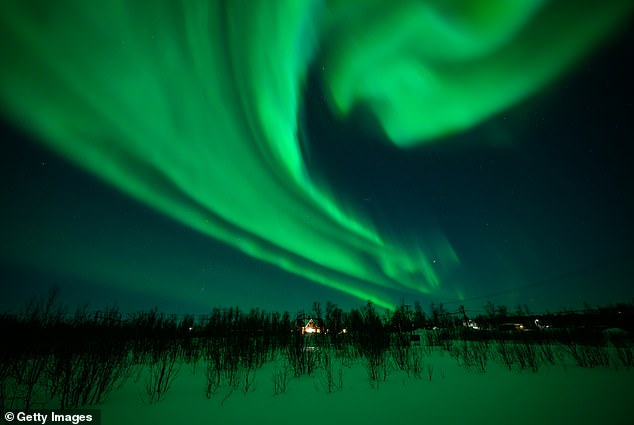A burst of energy from the sun is set to hit Earth on Thanksgiving, triggering stunning northern lights in the night sky.
Most of Washington, Montana, the Dakotas, Minnesota, Wisconsin, Michigan and Maine are positioned for potential auroras.
And northern regions of Idaho, Wyoming, New York, Vermont and New Hampshire may also see the phenomena.
Americans should step outside between 10pm ET and 1am ET to captured the best views, ideally away from bright city lights.
Taking a picture with a smartphone camera may also reveal hints of the aurora that are not visible to the naked eye.
Meanwhile, the National Oceanic and Atmospheric Administration (NOAA) warned a geomagnetic storm is expected Thursday that could impact radios, satellites and GPS, which will linger into Black Friday.
‘Power grid fluctuations can occur. High-latitude power systems may experience voltage alarms,’ NOAA shared.
‘Satellite orientation irregularities may occur; increased drag on low Earth-orbit satellites is possible.’

Americans are expected to see stunning northern lights on Thanksgiving after the sun released a burst of energy Sunday
Pale auroras may be seen across many northern states Thursday and Friday, but they may be brief and seeing them will depend on how intense the solar storms get, NOAA meteorologist Mike Bettwy said.
Both the northern lights and geomagnetic storm are due to a coronal mass ejection (CEM).
Solar flares are powerful bursts of radiation that stem from a release of magnetic energy associated with sunspots, and are the largest explosive events in the solar system.
THIS IS PAST TENSE, ARE WE REFERRING TO ONE THATS ALREADY HAPPENED? After the solar flare erupted, a second blast of high energy particles and solar plasma made a direct line for Earth – that was the CME.
Northern lights – also known as the aurora borealis – are a natural light show that occurs when charged particles from the sun interact with Earth’s magnetic field.

Most of Washington, Montana , the Dakotas, Minnesota , Wisconsin , Michigan and Maine are positioned for potential auroras. And northern regions of Idaho , Wyoming , New York, Vermont and New Hampshire may also see the colored lights
Aurora are most commonly seen in the auroral zone – a region within 1,550 miles of the North Pole. Typically, the lights can only be seen in areas including Scandinavia, Alaska and Iceland.
But geomagnetic storms can make them appear further south.
The sun unleashed a powerful stream of plasma late Sunday evening that is heading toward Earth.
NOAA’s warnings show the worst of the geomagnetic storm is expected Saturday.
The storm is a major disturbance in Earth’s magnetic field caused by a burst of energy from the sun,.
‘A G1 (Minor) watch has been issued for 28 Nov and a G2 (Moderate) watch was issued for 29 Nov due to the arrival of a CME associated with a filament eruption that took off the sun late on 25 Nov,’ NOAA shared.
The sun is currently at the maximum phase of its 11-year cycle, making solar surges and northern lights more frequent.
The sun released 20 flares over the last 24 hours, with one causing blackouts over the Indian Ocean.
The active period is expected to last for at least another year, though scientists won’t know when solar activity peaked until months after the fact, according to NASA.
While geomagnetic storms can cause radio blackouts, experts do not expect major communication disruptions from this week’s solar storm.
This article was originally published by a www.dailymail.co.uk . Read the Original article here. .


